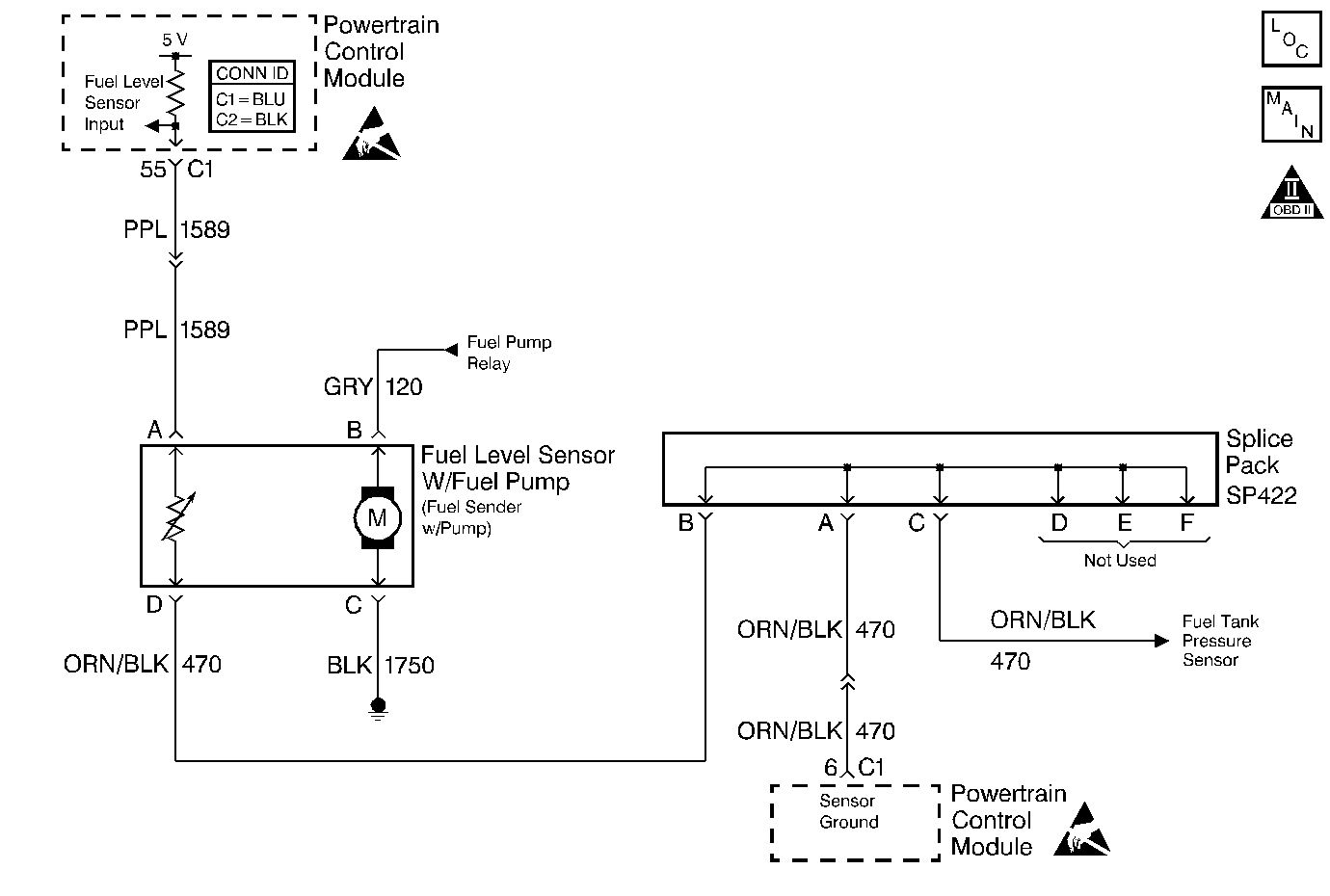
Circuit Description
The Fuel Level Sensor changes resistance based on fuel level. The Fuel Level Sensor has a signal circuit and a ground circuit. The PCM applies a voltage (about 5.0 volts) on the signal circuit to the sensor. The PCM monitors changes in this voltage caused by changes in the resistance of the sensor to determine fuel level.
When the fuel tank is full, the sensor resistance is high, therefore, the PCM will sense a high signal voltage (fuel tank full). When the fuel tank is empty, the sensor resistance is low, and the PCM senses a low signal voltage (fuel tank empty).
The PCM uses inputs from the Fuel Level Sensor to calculate the total fuel remaining in the fuel tank. This information is then sent to the fuel gauge via the class 2 circuit. The Fuel Level information is also used for misfire and EVAP diagnostics.
This DTC sets when the PCM senses a signal voltage greater than the normal operating range of the sensor.
Conditions for Running the DTC
| • | The ignition is ON. |
| • | The system voltage is between 11 and 16 volts. |
Conditions for Setting the DTC
Fuel level sensor reading is more than 98 percent for more than 25 seconds.
Action Taken When the DTC Sets
| • | The PCM will record the operating conditions during the time which the diagnostic fails. This information will store in the Failure Records buffer. |
| • | A history DTC is stored. |
Conditions for Clearing the DTC
| • | A history DTC clears after 40 consecutive warm up cycles without a fault. |
| • | The scan tool clears the DTC. |
Test Description
The numbers below refer to the step numbers on the Diagnostic Table.
-
This step determines if the fault is present.
-
This step is testing for a short to voltage. If the DMM displays a voltage greater than 5 volts, the fuel level signal circuit is shorted to a voltage.
-
This step is testing the fuel level signal circuit for a short to a 5 volt reference circuit.
Step | Action | Value(s) | Yes | No | ||||||||
|---|---|---|---|---|---|---|---|---|---|---|---|---|
1 | Did you perform the Powertrain On-Board Diagnostic (OBD) System Check ? | -- | ||||||||||
Is the fuel level sensor percentage above the specified value? | 98% | |||||||||||
3 |
Does the DTC fail this ignition? | -- | Go to Intermittent Conditions | |||||||||
Is the voltage above the specified value? | 5V | |||||||||||
5 |
Is the fuel level sensor percentage at the specified value? | 0% | ||||||||||
Monitor the parameters for the following components with a scan tool while the fuel level signal circuit is grounded:
Do any of the sensor voltages drop when the fuel level signal circuit is grounded? | -- | |||||||||||
7 | Jumper the fuel level sensor signal circuit to a known good ground. Is the fuel level sensor percentage at the specified value? | 0% | ||||||||||
8 | Test the fuel level sensor signal circuit for an open. Refer to Circuit Testing and Wiring Repairs in Wiring Systems. Did you find and correct the condition? | -- | ||||||||||
9 | Test the fuel level sensor ground circuit for an open. Refer to Circuit Testing and Wiring Repairs in Wiring Systems. Did you find and correct the condition? | -- | ||||||||||
10 | Inspect for poor connections at the harness connector of the fuel level sensor. Refer to Testing for Intermittent Conditions and Poor Connections and Connector Repairs in Wiring Systems. Did you find and correct the condition? | -- | ||||||||||
11 | Replace the fuel level sensor. Refer to Fuel Sender Assembly Replacement . Did you complete the replacement? | -- | -- | |||||||||
12 | Repair the signal circuit of the fuel level sensor for a short to a 5 volt reference circuit. Refer to Wiring Repairs in Wiring Systems. Did you complete the repair? | -- | -- | |||||||||
13 | Repair the signal circuit of the fuel level sensor for a short to voltage. Refer to Wiring Repairs in Wiring Systems. Did you complete the repair? | -- | -- | |||||||||
14 | Inspect for poor connections at the harness connector of the PCM. Refer to Testing for Intermittent Conditions and Poor Connections and Connector Repairs in Wiring Systems. Did you find and correct the condition? | -- | ||||||||||
15 | Replace the PCM. Refer to Powertrain Control Module Replacement/Programming . Did you complete the replacement? | -- | -- | |||||||||
16 |
Does the DTC run and pass? | -- | ||||||||||
17 | Select the Capture Info option and the Review Info option using the scan tool. Does the scan tool display any DTCs that you have not diagnosed? | -- | Go to the applicable DTC | System OK |
